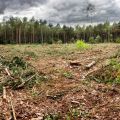Researchers extract ancient DNA from a 2,900-year-old clay brick, revealing a time capsule of plant life.
22 August 2023
- For the first time, a group of researchers have successfully extracted ancient DNA from a 2,900-year-old clay brick.
- The analysis provides a fascinating insight into the diversity of plant species cultivated at that time and place, and could open the way to similar studies on clay material from different sites and time periods.
- The results are published today in Nature Scientific Reports.
Currently housed at the National Museum of Denmark, the clay brick originates from the palace of Neo-Assyrian king Ashurnasirpal II, in the ancient city of Kalhu. Known today as the North-West palace in Nimrud (modern-day northern Iraq), its construction began around 879 BCE. The brick has a cuneiform inscription (written in the now extinct Semitic language Akkadian) stating that it is ‘The property of the palace of Ashurnasirpal, king of Assyria.’ This makes it possible to date the brick precisely to within a decade (879 BCE to 869 BCE).
During a digitalization project at the Museum in 2020, the group of researchers were able to obtain samples from the inner core of the brick - meaning that there was a low risk of DNA contamination since the brick was created. The team extracted DNA from the samples by adapting a protocol previously used for other porous materials, such as bone.
After the extracted DNA had been sequenced, the researchers identified 34 distinct taxonomic groups of plants. The plant families with the most abundant sequences were Brassicaceae (cabbage) and Ericaceae (heather). Other represented families were Betulaceae (birch), Lauraceae (laurels), Selineae (umbellifiers) and Triticeae (cultivated grasses).
With the interdisciplinary team comprising assyriologists, archaeologists, biologists, and geneticists, they were able to compare their findings with modern-day botanical records from Iraq as well as ancient Assyrian plant descriptions.
The brick would have been made primarily of mud collected near the local Tigris river, mixed with material such as chaff or straw, or animal dung. It would have been shaped in a mould before being inscribed with cuneiform script, then left in the sun to dry. The fact that the brick was never burned, but left to dry naturally, would have helped to preserve the genetic material trapped within the clay.
Dr Sophie Lund Rasmussen (Wildlife Conservation Research Unit, Department of Biology, University of Oxford), joint first author of the paper, said: ‘We were absolutely thrilled to discover that ancient DNA, effectively protected from contamination inside a mass of clay, can successfully be extracted from a 2,900-year-old clay brick. This research project is a perfect example of the importance of interdisciplinary collaboration in science, as the diverse expertise included in this study provided a holistic approach to the investigation of this material and the results it yielded.’
In addition to the fascinating insight this individual brick revealed, the research serves as a proof of concept and method which could be applied to many other archaeological sources of clay from different places and time periods around the world, to identify past flora and fauna. Clay materials are nearly always present in any archaeological site around the world, and their context means they can often be dated with high precision.
This study only described the plant DNA extracted, as these were the most prevalent and best-preserved specimens. However, depending on the sample, all taxa could potentially be identified, including vertebrates and invertebrates. The ability to provide accurate descriptions of ancient biodiversity would be a valuable tool to better understand and quantify present day biodiversity loss, and to gain a deeper understanding of ancient and lost civilisations.
‘Because of the inscription on the brick, we can allocate the clay to a relatively specific period of time in a particular region, which means the brick serves as a biodiversity time-capsule of information regarding a single site and its surroundings. In this case, it provides researchers with a unique access to the ancient Assyrians’ said Dr Troels Arbøll, joint first author of the paper and junior research fellow at Faculty of Asian and Middle Eastern Studies, University of Oxford, when the study was conducted.
Notes to editors:
For media requests and interviews, contact Dr Sophie Lund Rasmussen: [email protected]. Images of the clay brick are available on request.
The study ‘Revealing the secrets of a 2900 year old clay brick, discovering a time capsule of ancient DNA’ will be published in Nature Scientific Reports at 10 am BST, Tuesday 22 August, 2023: https://doi.org/10.1038/s41598-023-38191-w. To view a copy of the manuscript before this under embargo, contact Dr Sophie Lund Rasmussen: [email protected]
The research was conducted in collaboration with Troels Pank Arbøll from Department of Cross-Cultural and Regional Studies, University of Copenhagen; Sophie Lund Rasmussen from the Wildlife Conservation Research Unit, Department of Biology, University of Oxford; Anne Haslund Hansen from Modern History and World Cultures, National Museum of Denmark; Nadieh de Jonge, Cino Pertoldi and Jeppe Lund Nielsen from Department of Chemistry and Bioscience, Aalborg University and Aalborg Zoo (CP).
About the University of Oxford
Oxford University has been placed number 1 in the Times Higher Education World University Rankings for the seventh year running, and number 2 in the QS World Rankings 2022. At the heart of this success are the twin-pillars of our ground-breaking research and innovation and our distinctive educational offer.
Oxford is world-famous for research and teaching excellence and home to some of the most talented people from across the globe. Our work helps the lives of millions, solving real-world problems through a huge network of partnerships and collaborations. The breadth and interdisciplinary nature of our research alongside our personalised approach to teaching sparks imaginative and inventive insights and solutions.
Through its research commercialisation arm, Oxford University Innovation, Oxford is the highest university patent filer in the UK and is ranked first in the UK for university spinouts, having created more than 200 new companies since 1988. Over a third of these companies have been created in the past three years. The university is a catalyst for prosperity in Oxfordshire and the United Kingdom, contributing £15.7 billion to the UK economy in 2018/19, and supports more than 28,000 full time jobs.
About Oxford University’s Wildlife Conservation Research Unit (WildCRU)
Founded in 1986, Oxford University’s Wildlife Conservation Research Unit (WildCRU) was the first university-based conservation research unit in Europe. Today we are recognised as a world leader in our field, conducting cutting-edge, original research to inform conservation based on excellent science. Our approach is empirical, interdisciplinary and collaborative. Our work underpins conservation strategy, informs project implementation and supports policy change at local and international levels. Our members have been drawn from more than thirty countries and our projects have a similarly international reach, ranging from the Scottish Highlands to Mongolia, West Africa and Borneo. The need for our efforts is greater than ever.
 Nature degradation could cause a 12% loss to UK GDP
Nature degradation could cause a 12% loss to UK GDP
 Landmark study definitively shows that conservation actions are effective at halting and reversing biodiversity loss
Landmark study definitively shows that conservation actions are effective at halting and reversing biodiversity loss
 Researchers find oldest undisputed evidence of Earth’s magnetic field
Researchers find oldest undisputed evidence of Earth’s magnetic field
 Honorary degree recipients for 2024 announced
Honorary degree recipients for 2024 announced
 Vice-Chancellor's innovative cross-curricular programme celebrated
Vice-Chancellor's innovative cross-curricular programme celebrated